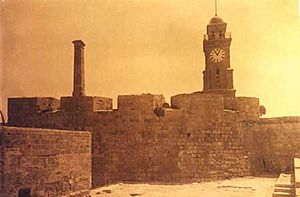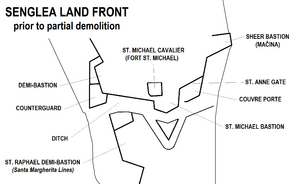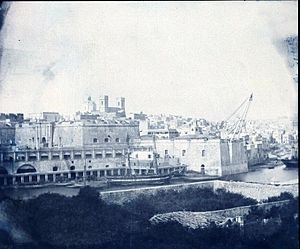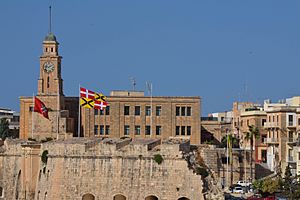Fort Saint Michael facts for kids
Quick facts for kids Fort Saint Michael |
|
|---|---|
| Forti San Mikiel | |
| Part of the fortifications of Senglea | |
| Senglea, Malta | |

St Michael Cavalier shortly before its demolition
|
|

Map of Senglea's land front, showing the location of Fort St. Michael
|
|
| Coordinates | 35°53′4.7″N 14°31′7.5″E / 35.884639°N 14.518750°E |
| Type | Cavalier |
| Site information | |
| Owner | Government of Malta |
| Condition | Part of base survives |
| Site history | |
| Built | 1552–1581 |
| Built by | Order of Saint John |
| Materials | Limestone |
| Fate | Partially demolished, 1921 |
| Battles/wars | Great Siege of Malta |
| Garrison information | |
| Past commanders |
Pierre de Monte (1565) |
Fort Saint Michael (also known as Forti San Mikiel in Maltese) was a small but very important fort in the city of Senglea, Malta. It was built way back in 1552. This fort played a huge role in the famous Great Siege of Malta in 1565. After the siege, it was rebuilt and became known as Saint Michael Cavalier (Kavallier ta' San Mikiel). Its reconstruction finished in 1581. Sadly, most of the cavalier was taken down in the 20th century. Today, only a small part of its base remains.
Contents
Building a Stronghold
In 1551, the Ottoman Empire attacked Malta. They even invaded the nearby island of Gozo. This made the Knights of Saint John realize they needed stronger defenses. Their leader, called the Grand Master Juan de Homedes y Coscon, decided to build two new forts.
One fort was planned for the Sciberras Peninsula. The other was for a smaller peninsula. This smaller area was then known as Isola di San Michele. It was located between two parts of the Grand Harbour, called Dockyard Creek and French Creek.
Laying the First Stone
The first stone for the fort on l'Isola was placed on May 8, 1552. Grand Master de Homedes himself laid it. A smart military engineer named Pedro Pardo d’Andrera designed the fort. The second fort, built on the Sciberras Peninsula, was named Fort Saint Elmo.
Becoming Part of Senglea
Later, Grand Master Claude de la Sengle decided to expand the fort. He turned it into a fortified city, which was named Senglea. This was part of the Knights' preparations for a big attack they expected. This attack became known as the Great Siege of Malta.
The Great Siege of Malta
The big attack finally happened in 1565. Fort Saint Michael was one of three main forts defending the Knights' stronghold in Grand Harbour. The other two were Fort St Angelo and Fort St Elmo. Fort St Elmo eventually fell to the Ottoman attackers.
However, Fort Saint Michael and Fort St Angelo bravely held strong. Fort Saint Michael was badly damaged during the siege. It was the site of some of the fiercest fighting. The fort managed to survive ten major attacks from the Ottoman army.
Rebuilding After the Siege
After the siege ended, the fortifications of Senglea were rebuilt. This work continued until 1581. Fort Saint Michael was changed into a cavalier. A cavalier is a tall tower with a strong, enclosed room inside. It had a flat top with ten openings for cannons.
In 1687, a man named Don Carlos de Grunenbergh visited the fort. He suggested adding another defensive wall, called a faussebraye. He even paid for it himself!
What Happened to the Fort?
Most of St. Michael Cavalier was taken down in 1921. This was done to make space for a new school. A small part of the lower section of the fort was kept. This remaining part was then used as the base for a clock tower.
Today, there's a part of the Senglea defenses called "the Spur." People often mistakenly call it Fort Saint Michael. But the actual Fort Saint Michael was located at the opposite end of the city.
Images for kids
See also
 In Spanish: Fuerte de San Miguel (Malta) para niños
In Spanish: Fuerte de San Miguel (Malta) para niños







